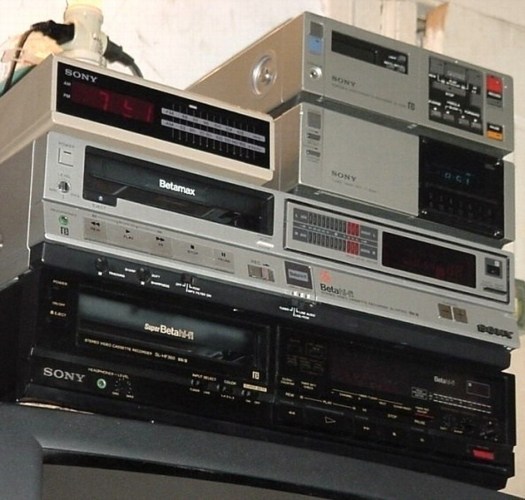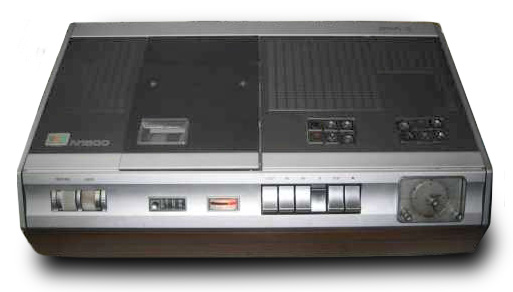|
VX (videocassette Format)
VX was a consumer analog recording videocassette format developed by Matsushita launched in 1975 in Japan which was short-lived and unsuccessful. In the United States, it was sold using the Quasar brand and marketed under the name "The Great Time Machine" to exhibit its time-shifting capabilities, since VX machines had a companion electro-mechanical clock timer for timed recording of television programs. In Japan, the VX-100 model was launched in 1975, with the VX-2000 following in 1976. The first and only model sold in North America was the Quasar VR-1000 (based on the Panasonic VX-2000), with the VT-100 timer. Design The VX cassette itself had both reels of magnetic tape stacked on top of each other in a coaxial fashion (much like the earlier Cartrivision and Philips VCR formats) in the bottom half of the tape, with a circular opening on the underside of the top half of the cassette, where the video head drum would enter. The tape in this opening was pre-formed in a loop to g ... [...More Info...] [...Related Items...] OR: [Wikipedia] [Google] [Baidu] |
Magnetic Tape
Magnetic tape is a medium for magnetic storage made of a thin, magnetizable coating on a long, narrow strip of plastic film. It was developed in Germany in 1928, based on the earlier magnetic wire recording from Denmark. Devices that use magnetic tape could with relative ease record and playback audio, visual, and binary computer data. Magnetic tape revolutionized sound recording and reproduction and broadcasting. It allowed radio, which had always been broadcast live, to be recorded for later or repeated airing. Since the early 1950s, magnetic tape has been used with computers to store large quantities of data and is still used for backup purposes. Magnetic tape begins to degrade after 10–20 years and therefore is not an ideal medium for long-term archival storage. Durability While good for short-term use, magnetic tape is highly prone to disintegration. Depending on the environment, this process may begin after 10–20 years. Over time, magnetic tape made in the 197 ... [...More Info...] [...Related Items...] OR: [Wikipedia] [Google] [Baidu] |
Cartrivision
Cartrivision is an analog videocassette format introduced in 1972, and the first format to offer feature films for consumer rental.1972: Cartrivision — The First VCR with Prerecorded Tapes CED Magic, cedmagic.com. Article retrieved 2006-12-22. Cartrivision was produced by Frank Stanton's Cartridge Television, Inc. (CTI), a subsidiary of ,"Cartrivision — The First ALL American Home VCR!" [...More Info...] [...Related Items...] OR: [Wikipedia] [Google] [Baidu] |
Audiovisual Introductions In 1975
Audiovisual (AV) is electronic media possessing both a sound and a visual component, such as slide-tape presentations, films, television programs, corporate conferencing, church services, and live theater productions. Audiovisual service providers frequently offer web streaming, video conferencing, and live broadcast services. Computer-based audiovisual equipment is often used in education, with many schools and universities installing projection equipment and using interactive whiteboard technology. Components Aside from equipment installation, two significant elements of audiovisual are wiring and system control. If either of these components are faulty or missing, the system may not demonstrate optimal performance. Wiring is a skill that not only requires proper cable rating selection based on a number of factors, including distance to the main rack, frequency and fire codes, but wires should also be out of sight, behind the walls and in the ceiling, when possible. Sy ... [...More Info...] [...Related Items...] OR: [Wikipedia] [Google] [Baidu] |
Heterodyne
A heterodyne is a signal frequency that is created by combining or mixing two other frequencies using a signal processing technique called ''heterodyning'', which was invented by Canadian inventor-engineer Reginald Fessenden. Heterodyning is used to shift signals from one frequency range into another, and is also involved in the processes of modulation and demodulation. The two input frequencies are combined in a nonlinear signal-processing device such as a vacuum tube, transistor, or diode, usually called a '' mixer''. In the most common application, two signals at frequencies and are mixed, creating two new signals, one at the sum of the two frequencies , and the other at the difference between the two frequencies . The new signal frequencies are called ''heterodynes''. Typically, only one of the heterodynes is required and the other signal is filtered out of the output of the mixer. Heterodyne frequencies are related to the phenomenon of "beats" in acoustics. A major a ... [...More Info...] [...Related Items...] OR: [Wikipedia] [Google] [Baidu] |
Helical Scan
Helical scan is a method of recording high-frequency signals on magnetic tape. It is used in open-reel video tape recorders, video cassette recorders, digital audio tape recorders, and some computer tape drives. History Earl E Masterson from RCA patented the first helical scan method in 1950 after stealing it from German engineer Eduard Schüller. Eduard Schüller developed an actually working helical scan method of recording in 1953 while working at AEG. With the advent of television broadcasting in Japan in the early 1950s, they saw the need for magnetic television signal recording. Dr. Kenichi Sawazaki developed a prototype helical scan recorder in 1954. Gallery Bcn-scanner-head.jpg, Type B videotape video scanner head Vxa1-drive-nocover-nobezel-front.jpg, rotary head visible in a VXA computer tape drive Vxa1-drive-nocover-top-front.jpg, VXA tape drive, alternate view of rotary head and loading mechanism See also * Type A videotape * 1 inch type B videotape * 1 i ... [...More Info...] [...Related Items...] OR: [Wikipedia] [Google] [Baidu] |
Betamax
Betamax (also known as Beta, as in its logo) is a consumer-level analog recording and cassette format of magnetic tape for video, commonly known as a video cassette recorder. It was developed by Sony and was released in Japan on May 10, 1975, followed by the US in November of the same year. Betamax is widely considered to be obsolete, having lost the videotape format war which saw its closest rival, VHS, dominate most markets. Despite this, Betamax recorders continued to be manufactured and sold until August 2002, when Sony announced that they were discontinuing production of all remaining Betamax models. Sony continued to sell Betamax cassettes until March 2016. Original version Launch and early models The first Betamax device introduced in the United States was the LV-1901 console, which included a color monitor, and appeared in stores in early November 1975. The cassettes contain videotape in a design similar to that of the earlier, professional , U-matic format. L ... [...More Info...] [...Related Items...] OR: [Wikipedia] [Google] [Baidu] |
Video Cassette Recording
Video Cassette Recording (VCR) is an early domestic analog recording format designed by Philips. It was the first successful consumer-level home videocassette recorder (VCR) system. Later variants included the VCR-LP and Super Video (SVR) formats. The VCR format was introduced in 1972, just after the Sony U-matic format in 1971. Although at first glance the two might appear to have been competing formats, they were aimed at very different markets. After failing as a consumer format, U-matic was marketed as a professional television production format, whilst VCR was targeted particularly at educational but also domestic users. Unlike some other early formats such as Cartrivision, the VCR format does record a high-quality video signal without resorting to Skip field. Home video systems had previously been available, but they were open-reel systems (such as the Sony CV-2000) and were expensive to both buy and operate. They were also unreliable and often only recorded in black and ... [...More Info...] [...Related Items...] OR: [Wikipedia] [Google] [Baidu] |
Philips
Koninklijke Philips N.V. (), commonly shortened to Philips, is a Dutch multinational conglomerate corporation that was founded in Eindhoven in 1891. Since 1997, it has been mostly headquartered in Amsterdam, though the Benelux headquarters is still in Eindhoven. Philips was formerly one of the largest electronics companies in the world, but is currently focused on the area of health technology, having divested its other divisions. The company was founded in 1891 by Gerard Philips and his father Frederik, with their first products being light bulbs. It currently employs around 80,000 people across 100 countries. The company gained its royal honorary title (hence the ''Koninklijke'') in 1998 and dropped the "Electronics" in its name in 2013, due to its refocusing from consumer electronics to healthcare technology. Philips is organized into three main divisions: Personal Health (formerly Philips Consumer Electronics and Philips Domestic Appliances and Personal Care), Connecte ... [...More Info...] [...Related Items...] OR: [Wikipedia] [Google] [Baidu] |
Magnetic Tape
Magnetic tape is a medium for magnetic storage made of a thin, magnetizable coating on a long, narrow strip of plastic film. It was developed in Germany in 1928, based on the earlier magnetic wire recording from Denmark. Devices that use magnetic tape could with relative ease record and playback audio, visual, and binary computer data. Magnetic tape revolutionized sound recording and reproduction and broadcasting. It allowed radio, which had always been broadcast live, to be recorded for later or repeated airing. Since the early 1950s, magnetic tape has been used with computers to store large quantities of data and is still used for backup purposes. Magnetic tape begins to degrade after 10–20 years and therefore is not an ideal medium for long-term archival storage. Durability While good for short-term use, magnetic tape is highly prone to disintegration. Depending on the environment, this process may begin after 10–20 years. Over time, magnetic tape made in the 197 ... [...More Info...] [...Related Items...] OR: [Wikipedia] [Google] [Baidu] |
NTSC
The first American standard for analog television broadcast was developed by National Television System Committee (NTSC)National Television System Committee (1951–1953), Report and Reports of Panel No. 11, 11-A, 12–19, with Some supplementary references cited in the Reports, and the Petition for adoption of transmission standards for color television before the Federal Communications Commission, n.p., 1953], 17 v. illus., diagrs., tables. 28 cm. LC Control No.:5402138Library of Congress Online Catalog/ref> in 1941. In 1961, it was assigned the designation CCIR System M, System M. In 1953, a second NTSC standard was adopted, which allowed for color television broadcast compatible with the existing stock of black-and-white receivers. It is one of three major color formats for analog television, the others being PAL and SECAM. NTSC color is usually associated with the System M. The only other broadcast television system to use NTSC color was the System J. Since the introdu ... [...More Info...] [...Related Items...] OR: [Wikipedia] [Google] [Baidu] |
Television Program
Television, sometimes shortened to TV, is a telecommunication medium for transmitting moving images and sound. The term can refer to a television set, or the medium of television transmission. Television is a mass medium for advertising, entertainment, news, and sports. Television became available in crude experimental forms in the late 1920s, but only after several years of further development was the new technology marketed to consumers. After World War II, an improved form of black-and-white television broadcasting became popular in the United Kingdom and the United States, and television sets became commonplace in homes, businesses, and institutions. During the 1950s, television was the primary medium for influencing public opinion.Diggs-Brown, Barbara (2011''Strategic Public Relations: Audience Focused Practice''p. 48 In the mid-1960s, color broadcasting was introduced in the U.S. and most other developed countries. The availability of various types of archival storag ... [...More Info...] [...Related Items...] OR: [Wikipedia] [Google] [Baidu] |








